Bismuth Sulfide Doped in Graphitic Carbon Nitride Degrades Nitric Oxide under Solar Irradiation
Abstract
:1. Introduction
2. Materials and Methods
2.1. Chemicals
2.2. Synthesis of Photocatalysts
2.2.1. Synthesis of Bi2S3
2.2.2. Synthesis of g-C3N4 and Bi2S3@g-C3N4
2.3. Characterization Procedure
2.4. Experiments Evaluating Photocatalytic Activity
2.4.1. Experimental Procedure
2.4.2. Photocatalytic Activity
2.4.3. Evaluation of Active Species
3. Results and Discussion
3.1. Characterizations
3.2. Photocatalytic Test
3.3. Photocatalytic Mechanism of NO Degradation
4. Conclusions
Author Contributions
Funding
Institutional Review Board Statement
Informed Consent Statement
Data Availability Statement
Conflicts of Interest
References
- Shang, H.; Li, M.; Li, H.; Huang, S.; Mao, C.; Ai, Z.; Zhang, L. Oxygen vacancies promoted the selective photocatalytic removal of NO with blue TiO2 via simultaneous molecular oxygen activation and photogenerated hole annihilation. Environ. Sci. Technol. 2019, 53, 6444–6453. [Google Scholar] [CrossRef] [PubMed]
- Dvořák, R.; Chlápek, P.; Jecha, D.; Puchýř, R.; Stehlík, P. New approach to common removal of dioxins and NOx as a contribution to environmental protection. J. Clean. Prod. 2010, 18, 881–888. [Google Scholar] [CrossRef]
- Houshfar, E.; Lovas, T.; Skreiberg, O. Detailed chemical kinetics modeling of NOx reduction in combined staged fuel and staged air combustion of biomass. In Proceedings of the 18th European Biomass Conference and Exhibition, Lyon, France, 3–7 May 2010. [Google Scholar]
- Li, H.; ElKady, A.; Evulet, A. Effect of exhaust gas recirculation on NOx formation in premixed combustion system. In Proceedings of the 47th AIAA Aerospace Sciences Meeting Including the New Horizons Forum and Aerospace Exposition, Orlando, FL, USA, 5–8 January 2009. [Google Scholar]
- Charles, E.B. Industrial Combustion Pollution and Control; CRC Press: Boca Raton, FL, USA, 2003. [Google Scholar]
- Nikokavoura, A.; Trapalis, C. Graphene and g-C3N4 based photocatalysts for NOx removal: A review. Appl. Surf. Sci. 2018, 430, 18–52. [Google Scholar] [CrossRef]
- Dalton, J.S.; Janes, P.A.; Jones, N.; Nicholson, J.A.; Hallam, K.R.; Allen, G.C. Photocatalytic oxidation of NOx gases using TiO2: A surface spectroscopic approach. Environ. Pollut. 2002, 120, 415–422. [Google Scholar] [CrossRef]
- Devahasdin, S.; Fan, C., Jr.; Li, K.; Chen, D.H. TiO2 photocatalytic oxidation of nitric oxide: Transient behavior and reaction kinetics. J. Photochem. Photobiol. A 2003, 156, 161–170. [Google Scholar] [CrossRef]
- Poon, C.S.; Cheung, E. NO removal efficiency of photocatalytic paving blocks prepared with recycled materials. Constr. Build. Mater. 2007, 21, 1746–1753. [Google Scholar] [CrossRef]
- Ballari, M.; Hunger, M.; Hüsken, G.; Brouwers, H. NOx photocatalytic degradation employing concrete pavement containing titanium dioxide. Appl. Catal. B 2010, 95, 245–254. [Google Scholar] [CrossRef]
- Huang, Y.; Cao, J.-J.; Kang, F.; You, S.-J.; Chang, C.-W.; Wang, Y.-F. High selectivity of visible-light-driven La-doped TiO2 photocatalysts for NO removal. Aerosol Air Qual Res. 2017, 17, 2555–2565. [Google Scholar] [CrossRef] [Green Version]
- Li, Y.; Cui, W.; Liu, L.; Zong, R.; Yao, W.; Liang, Y.; Zhu, Y. Removal of Cr (VI) by 3D TiO2-graphene hydrogel via adsorption enriched with photocatalytic reduction. Appl. Catal. B 2016, 199, 412–423. [Google Scholar] [CrossRef]
- Wang, Y.; Cheng, H.; Zhang, L.; Hao, Y.; Ma, J.; Xu, B.; Li, W. The preparation, characterization, photoelectrochemical and photocatalytic properties of lanthanide metal-ion-doped TiO2 nanoparticles. J. Mol. Catal. A Chem. 2000, 151, 205–216. [Google Scholar] [CrossRef]
- Ranjit, K.; Willner, I.; Bossmann, S.; Braun, A. Lanthanide oxide-doped titanium dioxide photocatalysts: Novel photocatalysts for the enhanced degradation of p-chlorophenoxyacetic acid. Environ. Sci. Technol. 2001, 35, 1544–1549. [Google Scholar] [CrossRef] [PubMed]
- He, Y.; Zhang, L.; Teng, B.; Fan, M. New application of Z-scheme Ag3PO4/g-C3N4 composite in converting CO2 to fuel. Environ. Sci. Technol. 2015, 49, 649–656. [Google Scholar] [CrossRef] [PubMed]
- Mamba, G.; Mishra, A. Graphitic carbon nitride (g-C3N4) nanocomposites: A new and exciting generation of visible light driven photocatalysts for environmental pollution remediation. Appl. Catal. B 2016, 198, 347–377. [Google Scholar] [CrossRef]
- Wang, X.; Chen, X.; Thomas, A.; Fu, X.; Antonietti, M. Metal-containing carbon nitride compounds: A new functional organic–metal hybrid material. Adv. Mater. 2009, 21, 1609–1612. [Google Scholar] [CrossRef]
- Cao, S.; Low, J.; Yu, J.; Jaroniec, M. Polymeric photocatalysts based on graphitic carbon nitride. Adv. Mater. 2015, 27, 2150–2176. [Google Scholar] [CrossRef]
- Faisal, M.; Jalalah, M.; Harraz, F.A.; El-Toni, A.M.; Khan, A.; Al-Assiri, M. Au nanoparticles-doped g-C3N4 nanocomposites for enhanced photocatalytic performance under visible light illumination. Ceram. Int. 2020, 46, 22090–22101. [Google Scholar] [CrossRef]
- Li, Z.; Kong, C.; Lu, G. Visible photocatalytic water splitting and photocatalytic two-electron oxygen formation over Cu-and Fe-doped g-C3N4. J. Phys. Chem. C 2016, 120, 56–63. [Google Scholar] [CrossRef]
- Zhao, R.; Sun, X.; Jin, Y.; Han, J.; Wang, L.; Liu, F. Au/Pd/g-C3N4 nanocomposites for photocatalytic degradation of tetracycline hydrochloride. J. Mater. Sci. 2019, 54, 5445–5456. [Google Scholar] [CrossRef]
- Liu, Z.; Zhang, M.; Wu, J. Enhanced Visible-Light Photocatalytic and Antibacterial Activities of Ag-Doped g-C3N4 Nanocomposites. ChemistrySelect 2018, 3, 10630–10636. [Google Scholar]
- Chen, W.; Liu, T.; Huang, T.; Liu, X.; Yang, X. Novel mesoporous P-doped graphitic carbon nitride nanosheets coupled with ZnIn2S4 heterostructures with remarkably enhanced. Nanoscale 2016, 8, 3711–3719. [Google Scholar] [CrossRef]
- Han, Q.; Hu, C.; Zhao, F.; Zhang, Z.; Chen, N.; Qu, L. One-step preparation of iodine-doped graphitic carbon nitride nanosheets as efficient photocatalysts for visible light water splitting. J. Mater. Chem. 2015, 3, 4612–4619. [Google Scholar] [CrossRef]
- Sagara, N.; Kamimura, S.; Tsubota, T.; Ohno, T. Photoelectrochemical CO2 reduction by a p-type boron-doped g-C3N4 electrode under visible light. Appl. Catal. B 2016, 192, 193–198. [Google Scholar] [CrossRef] [Green Version]
- Xu, C.; Han, Q.; Zhao, Y.; Wang, L.; Li, Y.; Qu, L. Sulfur-doped graphitic carbon nitride decorated with graphene quantum dots for an efficient metal-free electrocatalyst. J. Mater. Chem. 2015, 3, 1841–1846. [Google Scholar] [CrossRef]
- Zhu, X.; Wang, Y.; Guo, Y.; Wan, J.; Yan, Y.; Zhou, Y.; Sun, C. Environmental-friendly synthesis of heterojunction photocatalysts g-C3N4/BiPO4 with enhanced photocatalytic performance. Appl. Surf. Sci. 2021, 544, 148–872. [Google Scholar] [CrossRef]
- Zhang, S.; Yang, Y.; Guo, Y.; Guo, W.; Wang, M.; Guo, Y.; Huo, M. Preparation and enhanced visible-light photocatalytic activity of graphitic carbon nitride/bismuth niobate heterojunctions. J. Hazard. Mater. 2013, 261, 235–245. [Google Scholar] [CrossRef]
- Luo, S.; Qin, F.; Zhao, H.; Liu, Y.; Chen, R. Fabrication uniform hollow Bi2S3 nanospheres via Kirkendall effect for photocatalytic reduction of Cr (VI) in electroplating industry wastewater. J. Hazard. Mater. 2017, 340, 253–262. [Google Scholar] [CrossRef]
- Shi, H.; Zhao, Y.; Fan, J.; Tang, Z. Construction of novel Z-scheme flower-like Bi2S3/SnIn4S8 heterojunctions with enhanced visible light photodegradation and bactericidal activity. Appl. Surf. Sci. 2019, 465, 212–222. [Google Scholar] [CrossRef]
- Qiao, X.-Q.; Zhang, Z.-W.; Li, Q.-H.; Hou, D.; Zhang, Q.; Zhang, J.; Bu, X. In situ synthesis of n–n Bi2MoO6 Bi2S3 heterojunctions for highly efficient photocatalytic removal of Cr (VI). J. Mater. Chem. 2018, 6, 22580–22589. [Google Scholar] [CrossRef]
- Hu, T.; Dai, K.; Zhang, J.; Zhu, G.; Liang, C. One-pot synthesis of step-scheme Bi2S3/porous g-C3N4 heterostructure for enhanced photocatalytic performance. Mater. Lett. 2019, 257, 126740. [Google Scholar] [CrossRef]
- An, T.D.; Phuc, N.V.; Tri, N.N.; Phu, H.T.; Hung, N.P.; Vo, V. Sulfur-doped g-C3N4 with enhanced visible-light photocatalytic activity. Appl. Mech. Mater. 2019, 889, 43–50. [Google Scholar] [CrossRef]
- Yu, W.; Chen, J.; Shang, T.; Chen, L.; Gu, L.; Peng, T. Direct Z-scheme g-C3N4/WO3 photocatalyst with atomically defined junction for H2 production. Appl. Catal. B 2017, 219, 693–704. [Google Scholar] [CrossRef]
- Moyseowicz, A. Scalable one-pot synthesis of bismuth sulfide nanorods as an electrode active material for energy storage applications. J. Solid State Electrochem. 2019, 23, 1191–1199. [Google Scholar] [CrossRef]
- Nguyen, M.T.; Tran, H.H.; You, S.-J.; Wang, Y.-F.; Van Viet, P. Green synthesis of Ag@SnO2 nanocomposites for enhancing photocatalysis of nitrogen monoxide removal under solar light irradiation. Catal. Commun. 2020, 136, 105902. [Google Scholar]
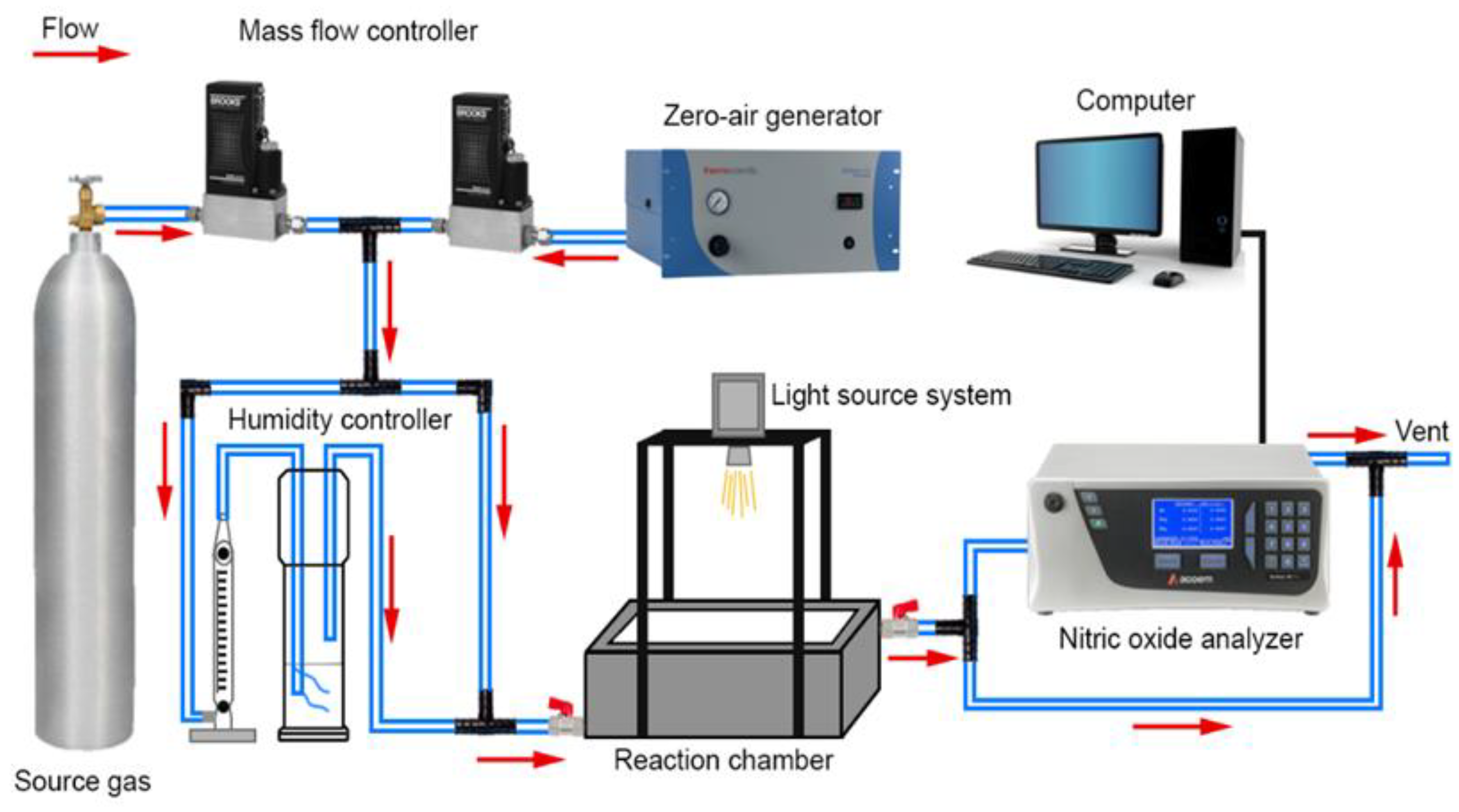
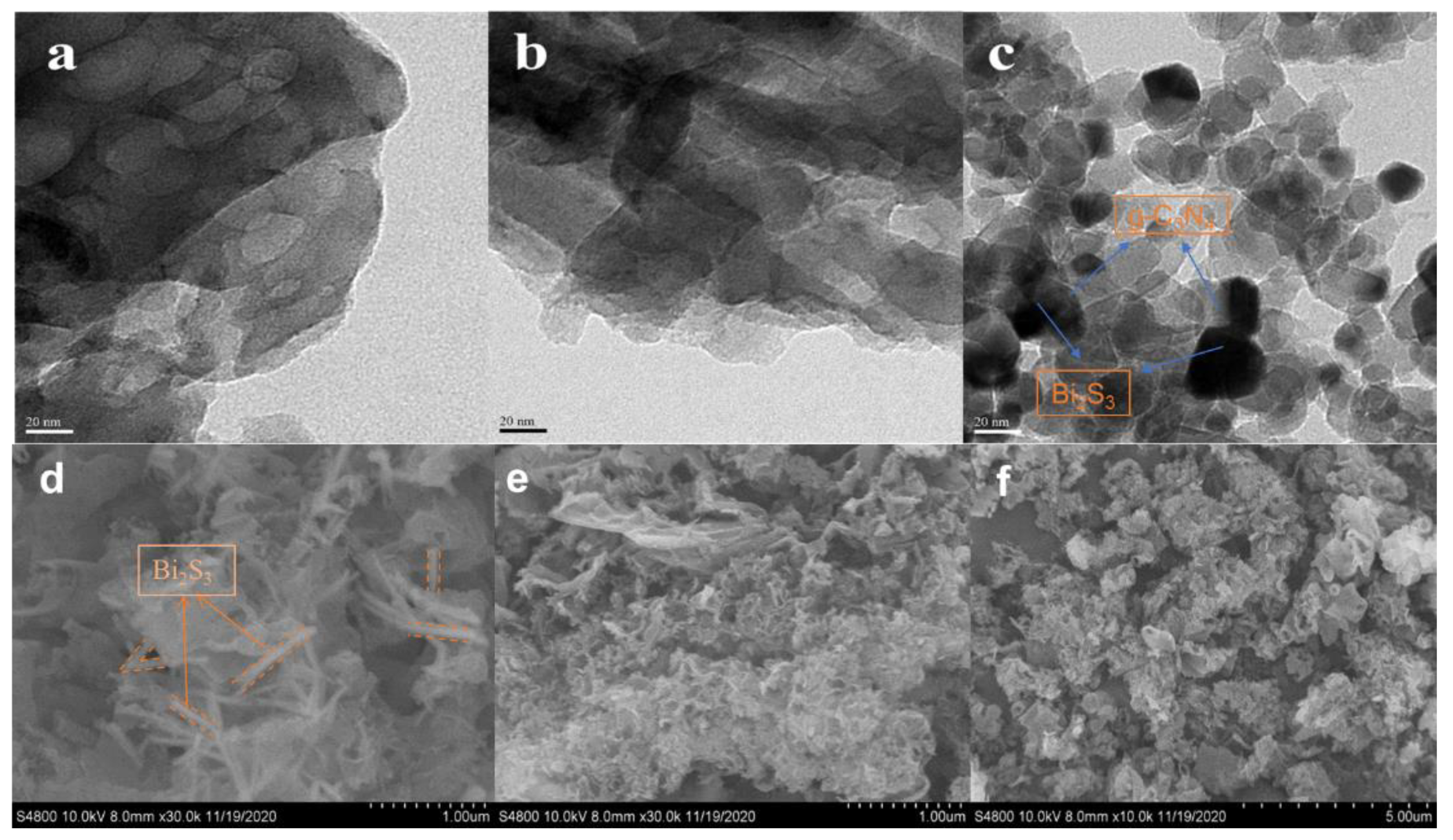

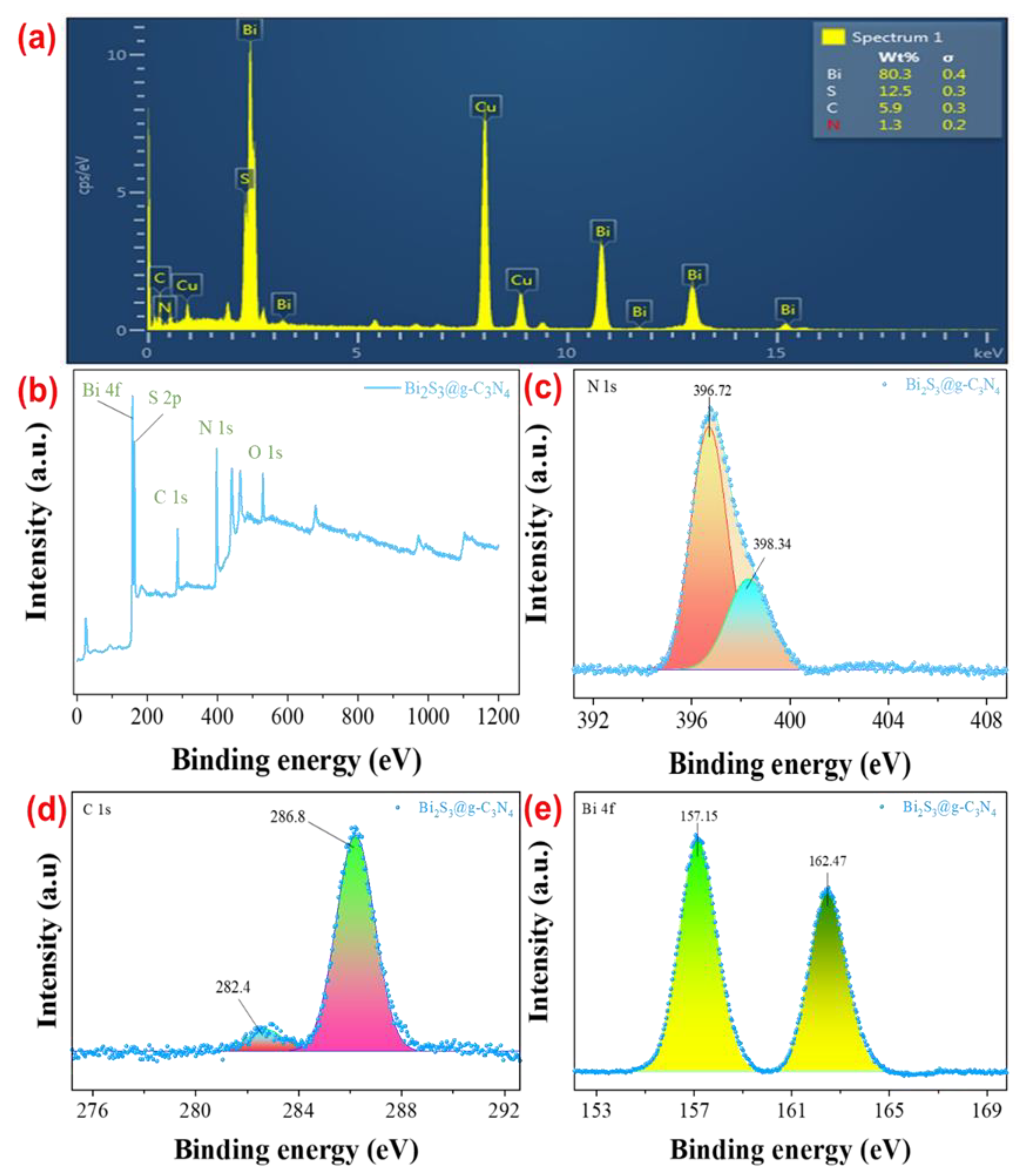
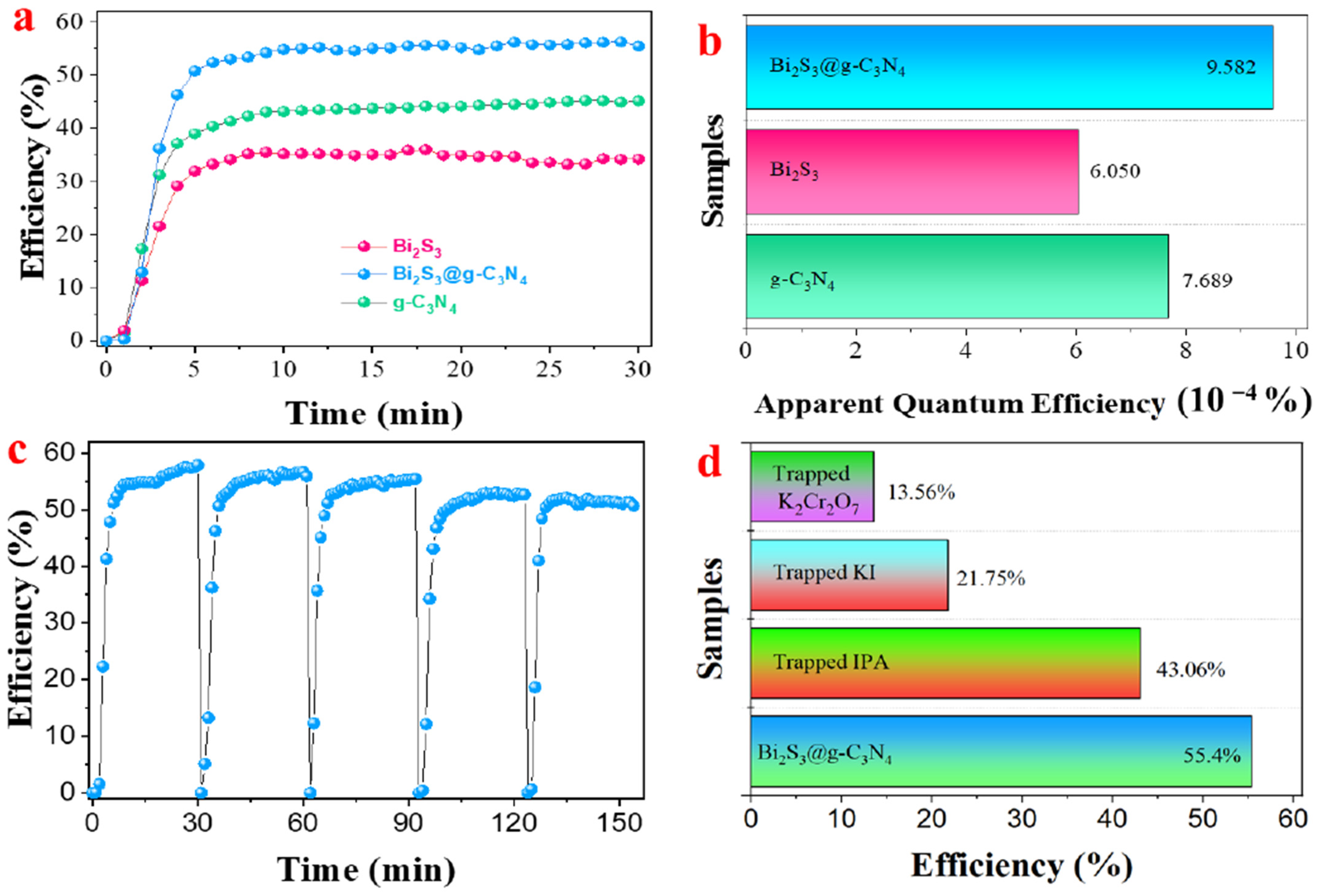
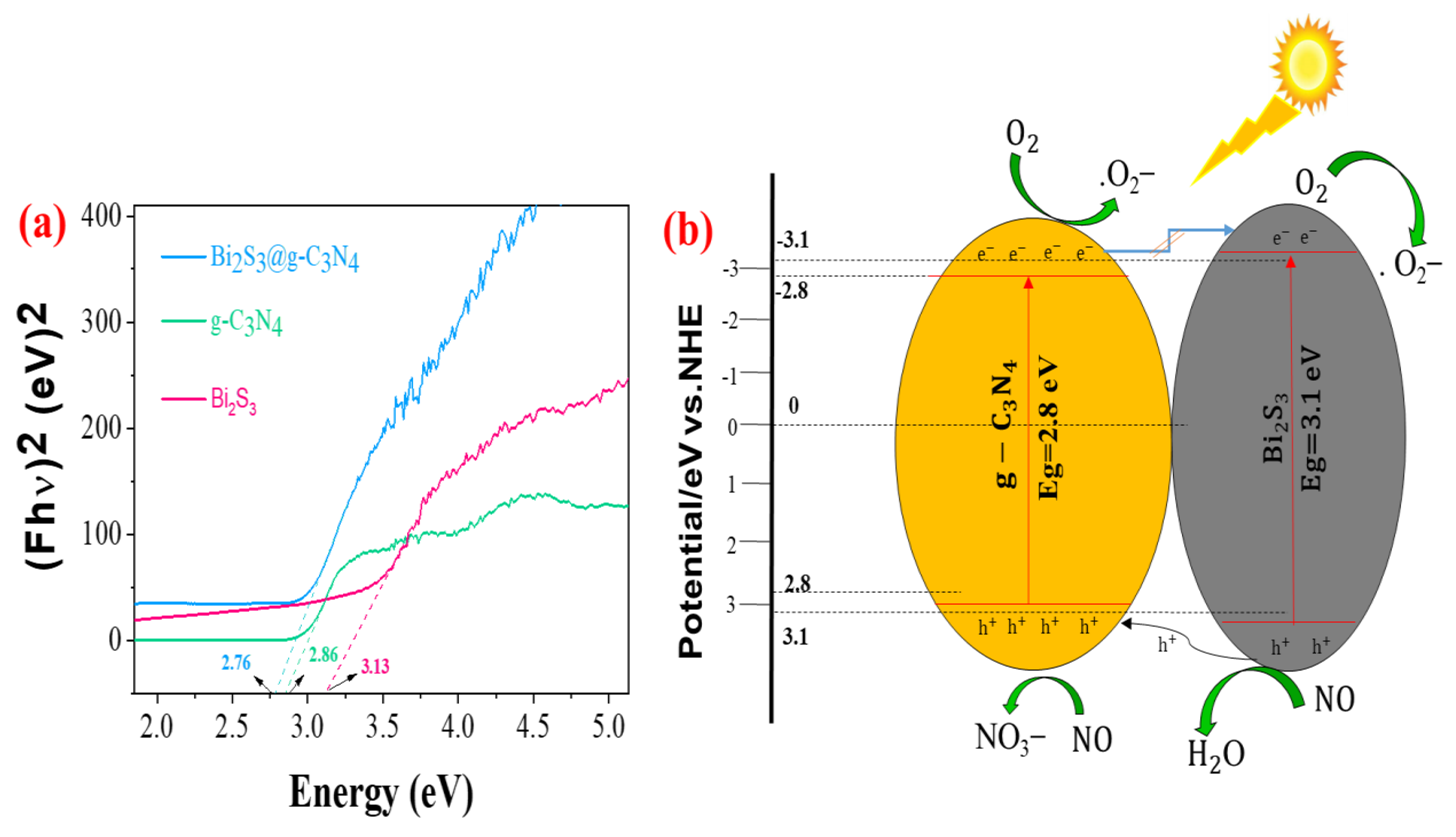
Publisher’s Note: MDPI stays neutral with regard to jurisdictional claims in published maps and institutional affiliations. |
© 2022 by the authors. Licensee MDPI, Basel, Switzerland. This article is an open access article distributed under the terms and conditions of the Creative Commons Attribution (CC BY) license (https://creativecommons.org/licenses/by/4.0/).
Share and Cite
Hussain, A.; Lin, C.; Cheruiyot, N.K.; Huang, W.-Y.; Lin, K.-S.; Hussain, A. Bismuth Sulfide Doped in Graphitic Carbon Nitride Degrades Nitric Oxide under Solar Irradiation. Nanomaterials 2022, 12, 3482. https://doi.org/10.3390/nano12193482
Hussain A, Lin C, Cheruiyot NK, Huang W-Y, Lin K-S, Hussain A. Bismuth Sulfide Doped in Graphitic Carbon Nitride Degrades Nitric Oxide under Solar Irradiation. Nanomaterials. 2022; 12(19):3482. https://doi.org/10.3390/nano12193482
Chicago/Turabian StyleHussain, Adnan, Chitsan Lin, Nicholas Kiprotich Cheruiyot, Wen-Yen Huang, Kuen-Song Lin, and Abrar Hussain. 2022. "Bismuth Sulfide Doped in Graphitic Carbon Nitride Degrades Nitric Oxide under Solar Irradiation" Nanomaterials 12, no. 19: 3482. https://doi.org/10.3390/nano12193482
APA StyleHussain, A., Lin, C., Cheruiyot, N. K., Huang, W.-Y., Lin, K.-S., & Hussain, A. (2022). Bismuth Sulfide Doped in Graphitic Carbon Nitride Degrades Nitric Oxide under Solar Irradiation. Nanomaterials, 12(19), 3482. https://doi.org/10.3390/nano12193482






